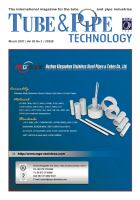

107
M
arch
/A
pril
2007
The comparison of the two furnace types can be summarized as
follows:
Channel-type induction furnaces (see figure 2) are used in
processes involving –
• Low power densities
• Large furnace capacity
• Bulky charge materials (cathodes etc)
• High pouring weights
• Continuous operating regimes
Coreless furnaces (see figure 3) offer significant benefits in
applications characterized by –
• High specific melting rate
• High power density
• Small-sized charge materials
• Frequent alloy changes
• Likelihood of segregation
• Long breaks or interruptions in operation
Due to the intensive bath movement, the coreless furnace is
undoubtedly the ideal melting tool for small-size material and swarf.
2.2 Holding and pouring
The channel-type induction furnace, offering the following benefits,
is undisputedly the preferred pouring system.
• Geometrical design versatility
• Simple siphon and forehearth integration
• Provision of separate chambers
• Pressure-tight design options
The type and design of a holding and pouring furnace is determined
primarily by the pouring technology in place. The melt feeding
situation is a key consideration here.
If the molten metal is supplied via launder or tundish, a practical
solution can be found in the gravity-flow pouring from the spout
of the coreless or channel-type furnace vessel where the alloy
composition permits the associated gas pick-up. Otherwise, the
molten metal must be poured via a siphon on a channel-type
furnace. With a coreless furnace this can only be obtained by
pouring the metal through the furnace pivot bearing.
For direct pouring into a mould or die via a stopper/nozzle system, a
channel-type furnace with forehearth may be the solution of choice,
as it prevents melt exposure to the atmosphere and thus ensures
a high degree of metal purity. With this furnace configuration,
however, heating can also be effected by a coreless inductor.
In horizontal continuous casting, the ingot mould defining the
strand geometry is built into the wall of the pouring furnace. As a
result, channel-type induction furnaces are usually selected for this
application.
The use of a standalone pouring and holding furnace of the
coreless type is reserved for exceptional cases; in some instances,
such furnaces are designed as short-coil units. Short-coil coreless
furnaces have a slightly lower electrical efficiency than channel-
type furnaces. As the heat losses are low, however, their holding
power consumption exceeds that of a channel-type only by narrow
margin. Moreover, a short-coil furnace can be operated with
full power input even at low heel levels, and it provides superior
conditions for alloying when compared to a channel-type furnace
system.
2.3 Rated power and power density
The potential power density of a channel furnace is limited by the
maximum power per inductor and, of course, by the number of
inductors. Currently, the maximum inductor rating for the melting
of copper is approximately 2,500kW. For design reasons, no
more than two high-power inductors per furnace vessel should be
used.
The power density of the coreless furnace is limited by the flux
level or bath movement which in turn rises with increasing power
and lowers with increasing frequency. The upper limit for mains-
frequency plants is 200-250kWh/t, but with 250Hz medium-
frequency plants, power densities of 500kWh/t are fairly common
without the risk of metal throw-outs.
The higher power density delivered by medium-frequency melting
furnaces is associated with an increased efficiency and hence,
reduced melting power needs. While a coreless-type mains
frequency furnace with a capacity of 10t and a 1,200kW power rating
›
Figure 3
:
Coreless furnace
fi
Figure 9
:
Example of a
melting furnace with pouring
through the pivot joint

















